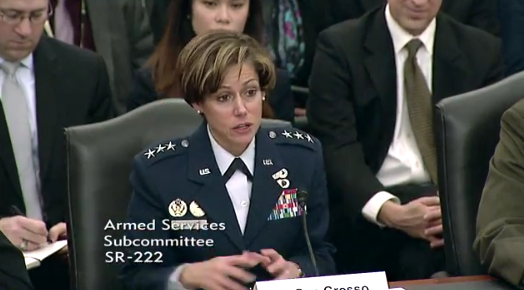
Lt. Gen. Gina Grosso, deputy chief of staff for manpower, personnel, and services, testifies before the Senate Armed Services Personnel Subcommittee on Jan. 24, 2018. Screenshot from SASC video.
A top Air Force official told Congress Wednesday the service is working to streamline the process for officer performance management, in light of success with enlisted promotion processes.
Lt. Gen. Gina Grosso, the deputy chief of staff for manpower, personnel, and services, discussed the effort during a Senate Armed Services subcommittee hearing on officer personnel management and the Defense Officer Personnel Management Act of 1980, or DOPMA.
The Air Force also is working on proposed changes to DOPMA to ensure recruitment of high-quality officers, she added.
In 2015, the Air Force transformed the enlisted evaluation and promotion processes “with much success,” and last year began a similar effort for officers, an effort involving “a thorough, deliberative review of our officer performance evaluation and officer promotion processes.”
“DOPMA flexibility, such as affording officers the option to opt out of promotion, increased authority regarding constructive credit, and improving permeability between the Active and reserve components, will greatly assist our efforts,” she told the committee.
The service now, she said, is looking into such steps as “increasing the number of competitive categories, creating a technical track, and establishing static promotion board dates.”
A draft “concept of operations with a four-phased approach to modernization” is now under review by senior Air Force leaders, the said.
She said the Air Force is “challenged in managing certain stressed career fields,” including pilots, cyber, special operations, intelligence, contracting, and some health professionals. She pointed to surveys showing that the top reasons officers leave the Air Force include maintenance of a work-life balance, potential time away from families, and too many permanent change-of-station moves.
“The theme we take from those departing officers is their desire for more control, flexibility, and stability in their career timing and advancement,” she said.
It is also important to remove barriers for officers moving from the Active component to the reserve component—a process that can now take months, resulting in many officers “sitting on the sideline” or pursuing other opportunities.
It is to the benefit of both the Air Force and the officers, she said, to speed the transition into the reserve component, and the service will continue efforts to speed the process, she said.
Meanwhile, she said, while DOPMA has “achieved its intended goals” to standardize management of the officer corps, it is time to “modernize,” and the Air Force is looking at possible changes.
The Air Force must compete for the best and brightest leaders, she said, and with a more competitive labor market, attracting and keeping those leaders “may require additional flexibilities in our personnel management governance.”
Officers, she said, are looking for more “agility and ability to manage their careers than DOPMA currently affords,” so the Air Force is looking at changes to modernize the law “to more effectively recruit, access, and retain” high-caliber officers.

